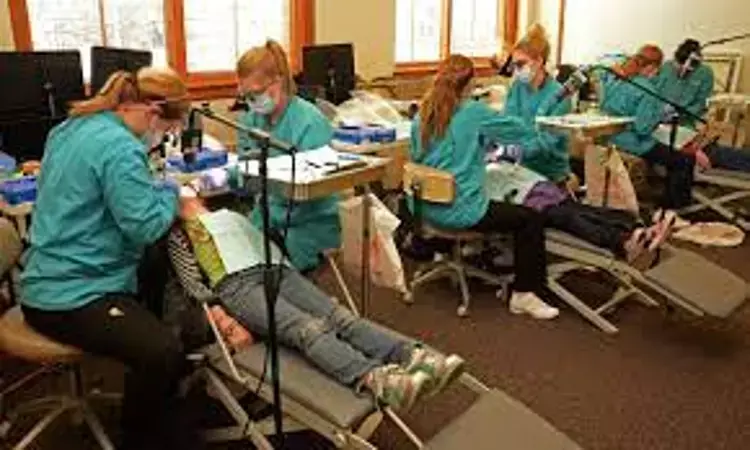- Home
- Medical news & Guidelines
- Anesthesiology
- Cardiology and CTVS
- Critical Care
- Dentistry
- Dermatology
- Diabetes and Endocrinology
- ENT
- Gastroenterology
- Medicine
- Nephrology
- Neurology
- Obstretics-Gynaecology
- Oncology
- Ophthalmology
- Orthopaedics
- Pediatrics-Neonatology
- Psychiatry
- Pulmonology
- Radiology
- Surgery
- Urology
- Laboratory Medicine
- Diet
- Nursing
- Paramedical
- Physiotherapy
- Health news
- Fact Check
- Bone Health Fact Check
- Brain Health Fact Check
- Cancer Related Fact Check
- Child Care Fact Check
- Dental and oral health fact check
- Diabetes and metabolic health fact check
- Diet and Nutrition Fact Check
- Eye and ENT Care Fact Check
- Fitness fact check
- Gut health fact check
- Heart health fact check
- Kidney health fact check
- Medical education fact check
- Men's health fact check
- Respiratory fact check
- Skin and hair care fact check
- Vaccine and Immunization fact check
- Women's health fact check
- AYUSH
- State News
- Andaman and Nicobar Islands
- Andhra Pradesh
- Arunachal Pradesh
- Assam
- Bihar
- Chandigarh
- Chattisgarh
- Dadra and Nagar Haveli
- Daman and Diu
- Delhi
- Goa
- Gujarat
- Haryana
- Himachal Pradesh
- Jammu & Kashmir
- Jharkhand
- Karnataka
- Kerala
- Ladakh
- Lakshadweep
- Madhya Pradesh
- Maharashtra
- Manipur
- Meghalaya
- Mizoram
- Nagaland
- Odisha
- Puducherry
- Punjab
- Rajasthan
- Sikkim
- Tamil Nadu
- Telangana
- Tripura
- Uttar Pradesh
- Uttrakhand
- West Bengal
- Medical Education
- Industry
Increasing stress on School sealant programs could reduce prevalence of caries: JADA

Increasing School sealant programs (SSPs) prevalence could reduce caries suggests a recent study published in the journal of the American Dental Association
School sealant programs (SSPs) increase sealant prevalence among children lacking access to oral health care. SSPs, however, are substantially underused. From 2013 through 2018, the Centers for Disease Control and Prevention funded 18 states for SSP activities in high-need schools (≥ 50% free and reduced-price meal program participation). From 2019 through 2020, the authors assessed SSPs' impact in reducing caries and how states expanded SSPs. The authors also discuss potential barriers to expansion.
For Aim 1, the authors used a published methodology and SSP baseline screening and 1-year retention data to estimate averted caries over 9 years attributable to SSPs. For Aim 2, the authors used state responses to an online survey, phone interviews, and annual administrative reports.
Results
- Using data for 62,750 children attending 18.6% of high-need schools in 16 states, the authors estimated that 7.5% of sound, unsealed molars would develop caries annually without sealants and placing 4 sealants would prevent caries in 1 molar.
- Fourteen states reported SSP expansion in high-need schools.
- The 2 most frequently reported barriers to SSP expansion were levels of funding and policies requiring dentists to be present at assessment or sealant placement.
The authors found that SSPs typically served children at elevated caries risk and reduced caries. In addition, the authors identified funding levels and policies governing supervision of dental hygienists as possible barriers to SSP expansion. Increasing SSP prevalence could reduce caries. Further research on potential barriers to SSP implementation identified in this study could provide critical information for long-term SSP sustainability.
Reference:
Nita Patel, et al. Impact of school sealant programs on oral health among youth and identification of potential barriers to implementation. Published:August 08, 2022DOI:https://doi.org/10.1016/j.adaj.2022.05.011
Key Words
Caries, fissure sealants, school program, school health, The Journal of the American Dental Association, Susan O. Griffin, Molly Linabarger, Srdjan Lesaja, Nita Patel
Dr. Shravani Dali has completed her BDS from Pravara institute of medical sciences, loni. Following which she extensively worked in the healthcare sector for 2+ years. She has been actively involved in writing blogs in field of health and wellness. Currently she is pursuing her Masters of public health-health administration from Tata institute of social sciences. She can be contacted at editorial@medicaldialogues.in.
Dr Kamal Kant Kohli-MBBS, DTCD- a chest specialist with more than 30 years of practice and a flair for writing clinical articles, Dr Kamal Kant Kohli joined Medical Dialogues as a Chief Editor of Medical News. Besides writing articles, as an editor, he proofreads and verifies all the medical content published on Medical Dialogues including those coming from journals, studies,medical conferences,guidelines etc. Email: drkohli@medicaldialogues.in. Contact no. 011-43720751


